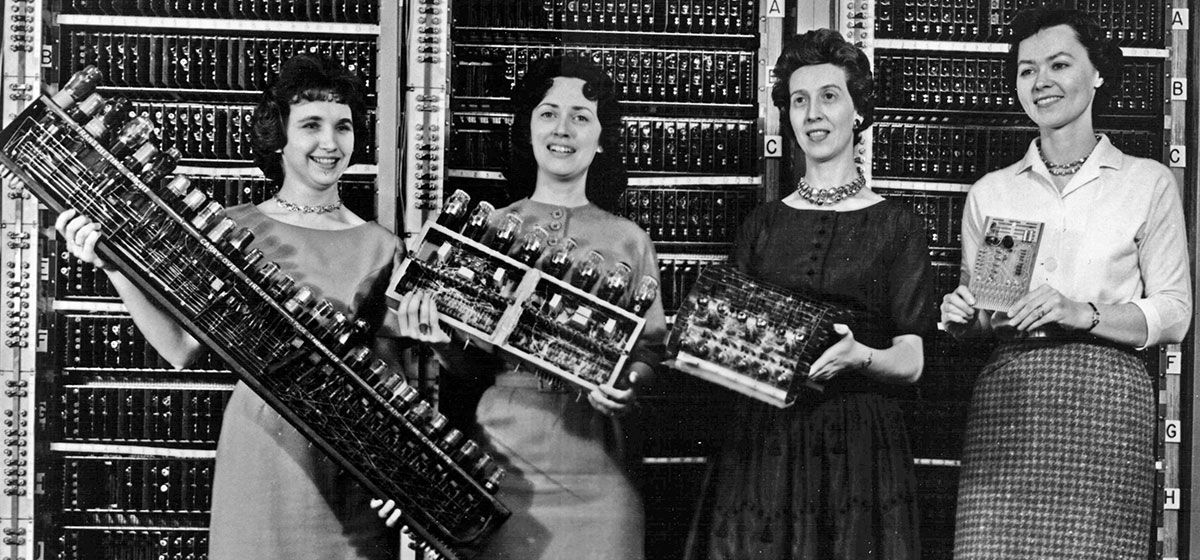Girl on the Move

I arrived at the Carnegie Institute of Technology in the fall of 1959 as a 16-year-old first year student in the architecture department in the College of Fine Arts. I had chosen architecture because I loved art and math ever since I was a kid, and architecture seemed like the perfect combination. Besides, I lived in Caracas, Venezuela, which had some of the most creative and beautiful architecture at the time. And my favorite high school math teacher, who was a missionary, had told me there was no future in math. “The best mathematics was done 2000 years ago.” I certainly did not want to go into a dead field.
I would soon change my mind, although doing so was more difficult than I imagined and would require the assistance of one of the greatest computer science minds this nation has ever produced.
I chose Carnegie Tech over the University of Pennsylvania because its architecture program was five years, one year shorter than Penn’s. I was a girl on the move.
I loved the ambiance of the architecture community at Tech. We all had drafting board space on long wooden tables in the huge, bright room on the top floor of the Fine Arts building. The first few lines of tables were for first-year students, the next few for second year, and so forth. I believe the 5th year students were way in back. Like most Fine Arts students, we worked on projects throughout the night, thus getting to know our classmates well. The upper division students would drop by our first-year drafting tables with encouragement and helpful advice.
Another advantage of having to work through the night was that I did not have the restrictive dorm sign-in hours of the time – 8 p.m., I believe – that women outside of Fine Arts had. Presumably to more easily manage us, all Fine Arts women were housed separately in the old Mellon mansion on top of a hill on Forbes Avenue near where the University Center stands today. I had a gorgeous single room with bay windows overlooking campus. In addition to the two other women in my architecture classes, I got to know art and drama students (dramats), several of whom became my good friends: Carol, Jessica, Eunice and Nina, an older student. The Mellon house was later demolished.
Many of the architecture students came from families in the construction or architecture businesses. They had worked summer jobs in the field and were passionate – inspired by Ayn Rand’s “The Fountainhead.” One classmate had even spent a summer at Taliesin West, Frank Lloyd Wright’s winter home and school in the Arizona desert.
But for me, except for a wonderful world history course that included weekly lectures on the arts, with a focus on Asian arts, the technical courses were not what I was seeking. The math and engineering were useful, but formulaic. I wanted to know why, not just how. I loved the beauty of math, the proofs in geometry, and found none of that beauty or deep understanding here. Mechanical drawing was useful, but I had wanted to draw and paint and sculpt. So, mid second year, I decided to switch either to art or math. I thought I would be able to do art on my own, which was naïve. But I certainly couldn’t do math on my own. So, switching to math seemed to me the right decision. But not to everyone, as I would soon find out.
Math at Carnegie Tech was in the College of Engineering and Science. Switching between colleges was not easy, particularly not from Fine Arts to Engineering. Even today, that would be difficult. Carnegie Mellon University today, as Carnegie Tech did then, generally accepts entering students into specific majors. And I was a Fine Arts girl.
During my sophomore year, I spoke to deans and knocked on many doors. I was told time after time it was impossible to switch majors; maybe I should think of seeing a counselor. That did not stop me. One day I knocked on a math professor’s door and, as usual, said I wanted to take math courses and become a math major. To my surprise, Alan Perlis immediately responded, “Great! I’m teaching an experimental math course using the computer (an IBM 650) in the basement of GSIA [the Graduate School of Industrial Administration]. You can take my class. The computer will grade all your makeup homework.”
Perlis’s course was not exactly the formal mathematics I was looking for, but it was quirky, forward-looking and definitely experimental. He was a lively enthusiastic, iconoclastic teacher, prancing around the classroom in sneakers, a striking figure with a bald head and lash-less piercing eyes. The archetypical Hollywood computer genius.
He would give us problems to solve that were all over the place – sometimes from numerical analysis, sometimes vaguely stated. He occasionally gave us problems that had no known solution at the time, although we were not told that. For example, the “firing squad problem.” The firing squad problem is now standard in all automata theory courses. For historical and cultural reasons, I often assign it for homework when I teach automata theory to undergrad computer science students at Carnegie Mellon, although the solution is now readily available on the web.
The firing squad problem is simply stated: Design a prototype automaton (a “soldier”) so that when any finite number of them are lined up and the “general” (the rightmost soldier) gives a signal, they will all fire simultaneously at some time. Of course, if they could all hear the general’s signal that would be no problem. What makes it tricky is that all the soldiers are exactly alike. They can only give and get signals from their closest neighbors to their right and left, which takes one unit of time. They cannot count, and they don’t have a clue how many soldiers are in the line. As I said, solutions are readily available on the web.
We had to solve our problems by writing programs in Perlis’s programming language, TASS, in which instructions had to be written on paper line by line. Each line then had to be coded (transcribed) onto a new computer punch card. The resulting stack of cards had to be taken down to the computer room in the basement of GSIA. God forbid if you tripped going down the stairs. If you were lucky, next morning you would get reams and reams of paper showing how your program ran on the computer, and the solution. If you were not lucky, well then you had to figure out if there was a bug in your program or in punching the cards.
The acronym TASS, which stood for Tech Assembly System, was pure Perlis. In Congress, the House Un-American Activities Committee set up to ferret out communists was still active. TASS was the name of the official Soviet Union news agency.
Perlis’s view of the “universal relevance” of computing across disciplines was prescient, even startling at the time. His experimental course led to a formal programming course he instituted at Carnegie Tech the following year.
It was in his experimental class, that I became aware of another archetype – the guy who spends day and night in the computer room writing and punching out computer programs. These early “hackers,” or computer geeks – like Bill Gates and Paul Allan – were of a more benign character than the computer hackers of today.
Because Perlis accepted me into his class, I was able to enroll in other math classes. I loved the challenge of the course on modern math, which I called the brick wall course – if you make it through you are on your way. But I was shocked by the new ambiance. No one seemed to talk to one another. I had lost the camaraderie I had experienced in architecture. I was on my own.
No longer a Fine Arts student, I had to abide by the restrictions placed on women students of the day, including the early dorm sign in. The double standard was stifling. A particularly egregious incident occurred during the spring term. One of the other two women in my architecture class also transferred out of Fine Arts and into Physics. She was brilliant and, I believe, the first in her family to go to college. One weekend, she signed out of the dorm to stay with her grandmother. Somehow it got back to the school that she was with her boyfriend. And even though the physics professor she was doing research with vouched for her, she was expelled from Tech and could not enter another university in the United States for some time. No such rules applied to her boyfriend.
I’m not sure exactly when I was officially declared a math major, but in June of 1961 I received a letter from the assistant dean of the College of Engineering.
Dear Miss Epstein (my maiden name),
Your final grades for the Spring 1961 semester again indicate excellent scholastic performance. It is, therefore, a great pleasure for me to close the 1960-61 academic year with this letter congratulating you, your parents and your high school teacher on this very fine record… You have made a fine start but much hard work remains to assure future success here at Carnegie Tech and a distinguished career after you graduate. We look forward to having you on campus again in September…
The letter was sent on June 27, 1961 to our address in Caracas with a 4-cent stamp. Apparently, the U.S. Post Office returned it for an additional 4 cents and it was mailed the next day.
I married that summer and moved to Cambridge, Mass. Alan Perlis became the first head of the computer science department at Carnegie Tech in 1965. And the following year he was awarded the first Turing Award, which is considered the Nobel Prize of computer science.
I received my Ph.D. in mathematics from the Massachusetts Institute of Technology in 1968, as Alan had done 18 years earlier. I would later meet him at scientific meetings. By then, he was in a wheel chair, but as lively and dynamic as ever and always eager to know how I was doing and what I was doing. In September 1999, nine years after Alan Perlis’s death, I returned to Pittsburgh to teach in the Carnegie Mellon Computer Science Department.





